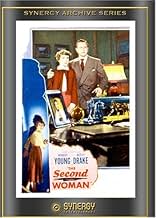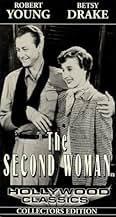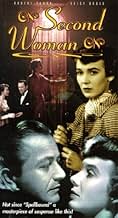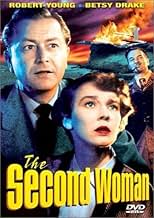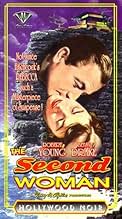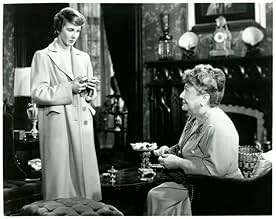NOTE IMDb
6,3/10
1,5 k
MA NOTE
Ajouter une intrigue dans votre langueIn flashback from a 'Rebecca'-style beginning: Ellen Foster, visiting her aunt on the California coast, meets neighbor Jeff Cohalan and his ultramodern clifftop house.In flashback from a 'Rebecca'-style beginning: Ellen Foster, visiting her aunt on the California coast, meets neighbor Jeff Cohalan and his ultramodern clifftop house.In flashback from a 'Rebecca'-style beginning: Ellen Foster, visiting her aunt on the California coast, meets neighbor Jeff Cohalan and his ultramodern clifftop house.
- Réalisation
- Scénario
- Casting principal
Jason Robards Sr.
- Stacy Rogers
- (as Jason Robards)
Jimmie Dodd
- Mr. Nelson
- (as Jimmy Dodd)
Smoki Whitfield
- Porter
- (scènes coupées)
Walter Bacon
- Country Club Guest
- (non crédité)
Vince Barnett
- Giovanni Strobini
- (non crédité)
Paul Bradley
- Country Club Guest
- (non crédité)
Avis à la une
The Second Woman (AKA: Ellen) is directed by James V. Kern and co- written by Mort Briskin and Robert Smith. It stars Robert Young, Betsy Drake, John Sutton, Florence Bates, Morris Carnovsky and Henry O'Neil. Music is by Joseph Nussbaum and cinematography by Hal Mohr.
Architect Jeff Cohalan (Young) is a troubled man, after the mysterious death of his fiancée in a car crash, he has been acting strangely and lives a lonely life at the Hilltop House he designed for his bride to be. When he meets Ellen Foster (Drake), things perk up as he becomes attracted to her. But he is constantly plagued by bad luck, something which doesn't go unnoticed by Ellen, who suspects that Jeff may not be the victim of paranoia, but of something sinister perpetrated by outside forces
The Coast of Kings.
If you can get away from the looming presence of such great films like Gaslight and Rebecca, then James Kern's movie holds some Gothic noir rewards. The house at the centre of tale is a modern development, which is a shame as it goes against the coastal atmosphere lifting up from the Carmel-On-Sea location that was used for these parts of the film, but otherwise there's a strong brooding mystery bubbling away throughout. As the bizarre instances of misfortune start to mount up on Jeff Cohalan, with director Kern showing a good appreciation of pacing, it builds up a menacing head of steam and then unravels a better than adequate denouement.
Vivian, Vivian, Vivian
Young and Drake inevitably tug at a romantic thread, but they make for an engaging couple and Drake especially gets her teeth into a female role of intelligent substance. John Sutton files in for some decent caddish quotient and Bates and O'Neil add some professionally elder support. Mohr's (Bullets or Ballets/The Lineup) photography is the key, consistently at one with the psychological beats of the plotting, his lighting compositions make the film seem far more higher in production value than it was.
A tale of memory lapses, pet bothering, depression, ugly real estate, dastards and romance, is nicely cloaked by ominous coastal atmospherics and Tchaikovsky! 7/10
Architect Jeff Cohalan (Young) is a troubled man, after the mysterious death of his fiancée in a car crash, he has been acting strangely and lives a lonely life at the Hilltop House he designed for his bride to be. When he meets Ellen Foster (Drake), things perk up as he becomes attracted to her. But he is constantly plagued by bad luck, something which doesn't go unnoticed by Ellen, who suspects that Jeff may not be the victim of paranoia, but of something sinister perpetrated by outside forces
The Coast of Kings.
If you can get away from the looming presence of such great films like Gaslight and Rebecca, then James Kern's movie holds some Gothic noir rewards. The house at the centre of tale is a modern development, which is a shame as it goes against the coastal atmosphere lifting up from the Carmel-On-Sea location that was used for these parts of the film, but otherwise there's a strong brooding mystery bubbling away throughout. As the bizarre instances of misfortune start to mount up on Jeff Cohalan, with director Kern showing a good appreciation of pacing, it builds up a menacing head of steam and then unravels a better than adequate denouement.
Vivian, Vivian, Vivian
Young and Drake inevitably tug at a romantic thread, but they make for an engaging couple and Drake especially gets her teeth into a female role of intelligent substance. John Sutton files in for some decent caddish quotient and Bates and O'Neil add some professionally elder support. Mohr's (Bullets or Ballets/The Lineup) photography is the key, consistently at one with the psychological beats of the plotting, his lighting compositions make the film seem far more higher in production value than it was.
A tale of memory lapses, pet bothering, depression, ugly real estate, dastards and romance, is nicely cloaked by ominous coastal atmospherics and Tchaikovsky! 7/10
It's opening speech tries far too hard to evoke associations with 'Rebecca' (it even features one of the original cast), and it also shoehorns in references to 'Suspicion' and 'Spellbound'. But it actually works perfectly own on it's own terms - with a bit of postwar psychology thrown in and Tchaikovsky on the soundtrack - and ironically harks forward towards later Hitchcocks (notably 'North by Northwest') with it's hero and heroine meeting cute on a train and the hilltop Frank Lloyd Wright-style house that serves as a backdrop to some of the drama.
A chicly attired Betsy Drake - ironically Mrs Cary Grant at the time - provides an attractive and robust female lead.
A chicly attired Betsy Drake - ironically Mrs Cary Grant at the time - provides an attractive and robust female lead.
Intriguing psychological thriller which reflects the forties zeitgeist when psychonanalysis was the craze (see "spellbound" " the dark mirror" "secret beyond the door"...)Because he feels responsible for the death of his fiancée in a car crash ,Jeff is brooding .And he's a victim of strange incidents (he has to shoot his horse whose front leg is broken, his dog is poisoned ) ;"it cannot be a coincidence " says Helen (who plays the role of Ingrid Bergman in "spellbound" although she's not a shrink ) .When the unfortunate man's house is burnt , all coincidence must be ruled out:
Is it a self-inflicted retribution ("he wants to be punished for what he's done) ,as the friendly doctor says , warning Helen and her aunt who accomodates him after the fire against a man who may become dangerous :he destroys everything he likes , and he loves you!
Or is there a criminal mind behind these strange events : hence a whodunit side: is it Ben,the late fiancée's father who treats Jeff like his own son?Keith the philanderer? Or the doctor himself ?
The screenplay sustains suspense throughout and the ending makes sense ; Robert Young as a brooding wistful man down on his luck and Betsy Drake, as headstrong energetic Helen come up to scratch.
Is it a self-inflicted retribution ("he wants to be punished for what he's done) ,as the friendly doctor says , warning Helen and her aunt who accomodates him after the fire against a man who may become dangerous :he destroys everything he likes , and he loves you!
Or is there a criminal mind behind these strange events : hence a whodunit side: is it Ben,the late fiancée's father who treats Jeff like his own son?Keith the philanderer? Or the doctor himself ?
The screenplay sustains suspense throughout and the ending makes sense ; Robert Young as a brooding wistful man down on his luck and Betsy Drake, as headstrong energetic Helen come up to scratch.
A better-than-average psychological thriller, The Second Woman blends aspects of Rebecca and Gaslight into a savvy, neo-Gothic style (there's even an ultramodern, Manderley-like pile of memories high above the crashing ocean; it, too, ends in conflagration).
Robert Young plays a young architect who can't wriggle out from under a jinx. The night before their wedding, a car crash claimed the life of his fiancée, for whom he'd built the cantilevered "house with wings." Now it's a mausoleum where he broods to the Tchaikovsky on the sound track. Lapses of memory and moody episodes undermine his work. His horse, his dog, even his prize rosebush die mysteriously. He's sinking, an object of pity and, increasingly, apprehension.
Into this slough of despond comes a guardian angel (Betsy Drake), an intelligent and independent insurance investigator who falls for him, as he for her. (She's something of an anomaly in film noir, where all the brains and spunk usually go to the wicked women.) She supplies Young with the resolve to solve the puzzle when he ceases to care.
There are weak points as well. The suicide attempt that opens the movie makes scant sense when it's later explained; the character set up as a villain emerges, at least partly, as a red herring; and the formidable Florence Bates disappears into a bland "also-starring" role. And constantly referring to past events in a low-key, almost abstract way lays poor preparation for the ending, where they prove central. Still, The Second Woman keeps you puzzled, and the Gothic trappings work their spell. Less film noir than mystery, it's nonetheless a good, old-fashioned one.
Robert Young plays a young architect who can't wriggle out from under a jinx. The night before their wedding, a car crash claimed the life of his fiancée, for whom he'd built the cantilevered "house with wings." Now it's a mausoleum where he broods to the Tchaikovsky on the sound track. Lapses of memory and moody episodes undermine his work. His horse, his dog, even his prize rosebush die mysteriously. He's sinking, an object of pity and, increasingly, apprehension.
Into this slough of despond comes a guardian angel (Betsy Drake), an intelligent and independent insurance investigator who falls for him, as he for her. (She's something of an anomaly in film noir, where all the brains and spunk usually go to the wicked women.) She supplies Young with the resolve to solve the puzzle when he ceases to care.
There are weak points as well. The suicide attempt that opens the movie makes scant sense when it's later explained; the character set up as a villain emerges, at least partly, as a red herring; and the formidable Florence Bates disappears into a bland "also-starring" role. And constantly referring to past events in a low-key, almost abstract way lays poor preparation for the ending, where they prove central. Still, The Second Woman keeps you puzzled, and the Gothic trappings work their spell. Less film noir than mystery, it's nonetheless a good, old-fashioned one.
What this b&w noir has going for it is the scenic grandeur of the central California coastline. The roiling sea and rocky outcrops, along with the ultra-modern (circa 1950) cliff house, provide an unusual backdrop to this psychological drama. Bad things keep happening to architect Jeff (Young) for no apparent reason, starting with the highway death of his wife. Enter Ellen (Drake) who seeks to uncover the mystery, though the finger of guilt begins to point at a grieving Jeff who may now be unhinged.
Both the script and the staging are excellent until the climax, which should have been reconsidered from both ends, especially the ludicrous gunshot that seemingly takes minutes to register. Drake's an appealing actress and projects intelligence in the part. At the same time, she's unusual for a decade that emphasized buxom sex-goddesses, which she definitely is not. She and Young do make a well-matched screen couple. However, Young's performance is rather strange. I don't know if he was reaching for a particular effect, but his low-key demeanor never changes despite the many provocations. Unfortunately, it borders on both the boring and the implausible.
Nonetheless, it's an intriguing mystery and a real treat for the eye thanks to cinematographer Hal Mohr. Also, I can't help noticing that Harry Popkin produced this film, along with the noir classic DOA (1950) and such imaginative B-movies as The Well (1951) and The Thief (1952). I expect it was he who insisted on the scenic locations for this film, proving that noir need not be confined to gritty urban settings. Anyway, I think it's fair to surmise that Popkin was a producer, unlike many, who understood the artistic side of movie-making. It shows here.
Both the script and the staging are excellent until the climax, which should have been reconsidered from both ends, especially the ludicrous gunshot that seemingly takes minutes to register. Drake's an appealing actress and projects intelligence in the part. At the same time, she's unusual for a decade that emphasized buxom sex-goddesses, which she definitely is not. She and Young do make a well-matched screen couple. However, Young's performance is rather strange. I don't know if he was reaching for a particular effect, but his low-key demeanor never changes despite the many provocations. Unfortunately, it borders on both the boring and the implausible.
Nonetheless, it's an intriguing mystery and a real treat for the eye thanks to cinematographer Hal Mohr. Also, I can't help noticing that Harry Popkin produced this film, along with the noir classic DOA (1950) and such imaginative B-movies as The Well (1951) and The Thief (1952). I expect it was he who insisted on the scenic locations for this film, proving that noir need not be confined to gritty urban settings. Anyway, I think it's fair to surmise that Popkin was a producer, unlike many, who understood the artistic side of movie-making. It shows here.
Le saviez-vous
- AnecdotesAt the beginning of the movie, Robert Young's character tries to commit suicide by running his car engine in an enclosed garage. Then in flashback, the doctor says that he's concerned about Young's character's recurring bouts of depression. In real life, Young suffered from depression for decades, and tried to commit suicide in Westlake Village, CA in January 1991 by running a hose from his exhaust pipe into the interior of his car. Young called a tow truck to try to start his car. The driver noticed the hose, and contacted the police.
- GaffesIn the opening scene, Robert Young's character is discovered suffocated by heavy carbon monoxide in a sealed garage, but nobody else coming in the garage is affected by the deadly gas. Additionally, unless a car is burning oil or running very rich, exhaust fumes are not visible as was shown here. This reveals some type of smoke or vapor was used, not an actual auto exhaust.
- Citations
Jeff Cohalan: Let's see what the tea leaves say about you... there's a trick my grandmother taught me; she learned it from an old witch in Ireland.
Ellen Foster: And so you've been drinking coffee ever since.
- ConnexionsReferenced in This Movie Must Die!: The Second Woman (1950) (2021)
Meilleurs choix
Connectez-vous pour évaluer et suivre la liste de favoris afin de recevoir des recommandations personnalisées
- How long is The Second Woman?Alimenté par Alexa
Détails
- Date de sortie
- Pays d’origine
- Sites officiels
- Langues
- Aussi connu sous le nom de
- The Second Woman
- Lieux de tournage
- Société de production
- Voir plus de crédits d'entreprise sur IMDbPro
- Durée
- 1h 31min(91 min)
- Couleur
- Rapport de forme
- 1.33 : 1
Contribuer à cette page
Suggérer une modification ou ajouter du contenu manquant

